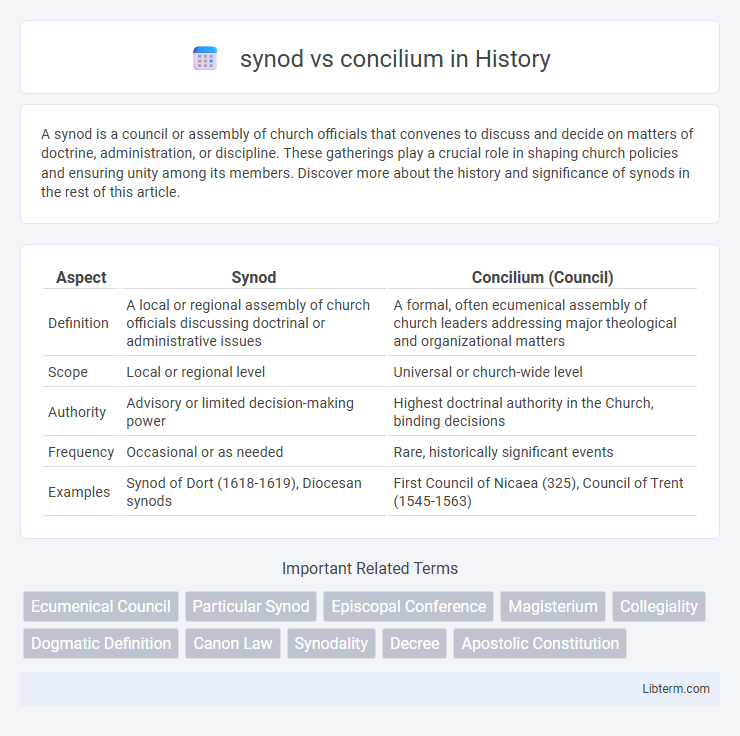A synod is a council or assembly of church officials that convenes to discuss and decide on matters of doctrine, administration, or discipline. These gatherings play a crucial role in shaping church policies and ensuring unity among its members. Discover more about the history and significance of synods in the rest of this article.
Table of Comparison
| Aspect | Synod | Concilium (Council) |
|---|---|---|
| Definition | A local or regional assembly of church officials discussing doctrinal or administrative issues | A formal, often ecumenical assembly of church leaders addressing major theological and organizational matters |
| Scope | Local or regional level | Universal or church-wide level |
| Authority | Advisory or limited decision-making power | Highest doctrinal authority in the Church, binding decisions |
| Frequency | Occasional or as needed | Rare, historically significant events |
| Examples | Synod of Dort (1618-1619), Diocesan synods | First Council of Nicaea (325), Council of Trent (1545-1563) |
Introduction to Synod and Concilium
A synod is a formal assembly of clergy and sometimes laity within a particular church or denomination, primarily convened to discuss and decide on doctrinal, liturgical, or administrative matters. The term concilium refers to a council, often larger and more authoritative, usually involving bishops from multiple dioceses or regions to address significant theological or ecclesial issues. Both synods and concilia serve as critical mechanisms for governance and unity in Christian tradition, with synods being more localized and concilia often having wider jurisdiction and impact.
Historical Origins of Synod and Concilium
The historical origins of synods trace back to early Christian communities where local assemblies of clergy and laity gathered to discuss doctrinal and pastoral matters, reflecting grassroots governance within the Church. Conciliums originated as more formal, ecumenical councils convened by emperors or high-ranking church authorities to address significant theological controversies and unify church doctrine across regions. These assemblies shaped the development of ecclesiastical law and church hierarchy by balancing localized input with centralized authority from the earliest centuries of Christianity.
Etymological Differences between Synod and Concilium
The terms "synod" and "concilium" originate from distinct etymological roots reflecting their historical and linguistic contexts. "Synod" derives from the Greek word "synodos," meaning "assembly" or "meeting," emphasizing a gathering for discussion or decision-making, primarily within Eastern and some Western Christian traditions. In contrast, "concilium" comes from the Latin term for "council," denoting a formal authoritative assembly, commonly used in the Western Church to signify official ecclesiastical gatherings with legislative or doctrinal authority.
Purpose and Functions of a Synod
A synod primarily serves as a consultative assembly within certain Christian denominations, designed to discuss and decide on church doctrine, discipline, and pastoral issues, ensuring alignment with ecclesiastical laws and traditions. Its functions include fostering unity among clergy and laity, addressing doctrinal controversies, and guiding the implementation of church teachings through collective deliberation. Unlike a concilium, which often denotes a larger council convened for broad doctrinal definitions or ecumenical purposes, a synod typically operates at regional or local levels, focusing on practical governance and pastoral care.
Purpose and Functions of a Concilium
A Concilium serves as a formal ecclesiastical council convened to deliberate on doctrinal, liturgical, or disciplinary matters, aiming to address significant issues within the Church's governance or theology. It functions to establish authoritative teachings, resolve disputes, and guide the faithful through official decrees or canons. Unlike broader synods, Concilium sessions typically involve a limited number of bishops or experts with specific mandates to implement or reform Church policies and practices.
Key Structural Differences
A synod typically refers to a council or meeting of church officials, often convened at local, regional, or national levels, focusing on specific issues or governance within a particular church tradition. In contrast, a concilium usually denotes a broader, more authoritative council with a universal scope, such as an ecumenical council in the Roman Catholic Church, involving bishops from the entire global church to address doctrinal and disciplinary matters. Structurally, synods often have a more limited jurisdiction and frequency, while concilia are rare, highly formalized, and hold supreme authoritative weight in defining church doctrine.
Decision-Making Processes
Synods and concilia differ significantly in their decision-making processes; synods typically involve regional or local bishops deliberating collaboratively on doctrinal or pastoral issues, emphasizing consensus within a specific ecclesiastical territory. Concilia, or ecumenical councils, convene a broader assembly of bishops from the entire Church, exercising authoritative and binding decisions on doctrine, discipline, and Church law, which have universal applicability. The legitimacy and implementation of conciliar decrees often require ratification by the pope, reinforcing the hierarchical structure within the Catholic Church's governance.
Notable Examples in Church History
The Council of Nicaea (325 AD) stands as a prominent example of a concilium, defining foundational Christian doctrines like the Nicene Creed. In contrast, synods such as the Synod of Whitby (664 AD) played critical roles in resolving regional liturgical disputes within the Church. Both concilia and synods significantly shaped ecclesiastical authority and doctrine throughout Christian history.
Impact on Church Governance
Synods function as advisory assemblies that influence Church governance by facilitating dialogue among bishops and laity to address pastoral issues, shaping local and regional decision-making. Concilium denotes a broader, often ecumenical council with authority to define doctrine and enact binding decrees, significantly altering the Church's hierarchical structure and governance principles. The impact of synods is typically incremental and consultative, whereas concilia induce authoritative, structural transformations in ecclesiastical governance.
Synod vs Concilium: Modern Applications
Synods and concilia serve distinct roles in modern ecclesiastical governance, with synods typically addressing regional or national church matters through assemblies of clergy and laity, fostering localized decision-making. Concilium, often referencing larger, ecumenical councils such as Vatican II, embodies comprehensive doctrinal and pastoral deliberations with global church implications. Contemporary applications of synods emphasize pastoral responsiveness and adaptability within specific contexts, while concilia shape universal church teachings and reforms.
synod Infographic

 libterm.com
libterm.com